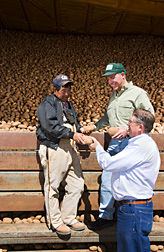This page has been archived and is being provided for reference purposes only. The page is no longer being updated, and therefore, links on the page may be invalid.
Read the magazine story to find out more. |
|
Improving Conservation in Potato Fields
By Laura McGinnisMay 9, 2006
Deep-rooted cover crops can help potato farmers prevent erosion and protect groundwater by reducing nitrate leaching. That’s one conclusion of Agricultural Research Service (ARS) scientists who developed several important tools and techniques to help growers manage their land economically and responsibly.
Heavily fertilized crops with shallow roots, like potatoes, are more susceptible to nitrate leaching, according to Jorge Delgado, a soil scientist in the ARS Soil Plant Nutrient Research Unit at Fort Collins, Colo. However, nitrogen recovery can be significantly improved—and leaching minimized—by using a deep-rooted cover crop like winter rye, malting barley or winter wheat.
Deep-rooted cover crops reduce wind erosion, sequester carbon, cycle nutrients and draw nitrate further from the soil than crops with shallow roots. Crops like winter cover rye and wheat can even be used for grazing.
Complementary potato research is being conducted in ARS labs at Prosser, Wash., and Orono, Maine.
In Prosser, scientists measured how much nitrogen Brassica cover crops contributed to the soil and how much was taken up by subsequent potato crops. Those studies found that about 30 percent of the nitrogen on the surface of the crop field was cycled back to the soil. Planting Brassica cover crops could save growers $15 to $20 per acre at current fertilizer prices.
Orono researchers modeled the influence of temperature on crop residue decomposition and nitrogen availability in order to predict the best time to apply additional fertilizer to meet the crop’s needs and potentially reduce the amount of nitrate lost to groundwater.
These efforts promote “precision conservation,” or management practices that incorporate elements of conservation and precision agriculture.
Read more about the research in the May 2006 issue of Agricultural Research magazine.
ARS is the U.S. Department of Agriculture’s principal scientific research agency.


